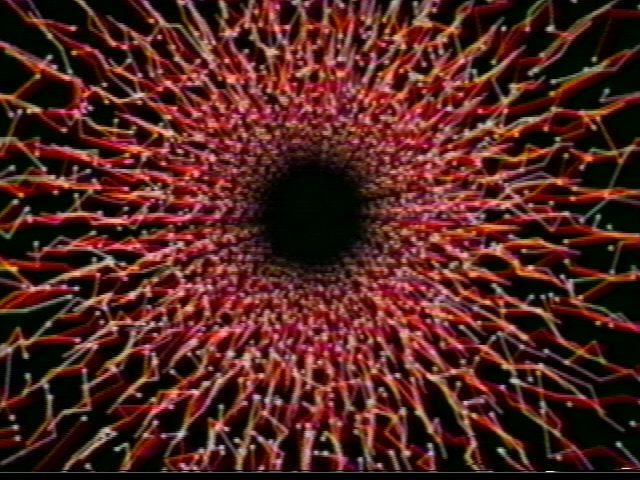Here: I am going to solve a mystery that has stumped people for the last thirty
years.
There is an urban legend about "Polybius", a mysterious eighties videogame that
made kids go insane. As the story goes, the videogame showed up without warning
in 1981 various Portland arcades. It featured subliminal messages and trippy
visuals that gave players nightmares and hallucinations. After a few months,
shadowy "men in black" downloaded data off the machine and confiscated all
copies of the videogame. Rumors persist of one remaining copy found in an Oregon
storage locker. See https://en.wikipedia.org/wiki/Polybius_(urban_legend) for
more details.
According to
internet posts in 1998 that remember the gameplay, "Polybius was supposed to
have the combined elements of Tempest and Galaga, resulting in a combination
puzzle and shooter game. It was one of the earliest games to use vector
graphics, geometrical primitives that are based on mathematical equations and
represented by points, lines, curves and shapes. Game play involved a moving
ship navigating a rotating screen and shooting at moving objects. As the player
completed each level, the difficulty was increased by instilling increasingly
distracting backgrounds. Consisting of wildly spinning graphics and brightly
colored, fast moving, hypnotic backgrounds, Polybius was said to have excelled
in popularity, and supposedly many people that played this game quickly became
addicted."
I am certain that the videogame in question was actually Cube
Quest (http://en.wikipedia.org/wiki/Cube_Quest).
Cube Quest was released in 1983, and was truly ground breaking. I loved playing
it at my local arcade. Keep in mind that in 1983, computer graphics were pretty
mediocre. There were "vector" videogames like Tempest which consisted of colored
line drawing on a screen. Other examples of popular vector games were Asteroids
and Battlezone. Fun games, sure, but they looked visually like primitive line
drawings. The other option at the time for computer graphics was "raster", where
the picture was made up of tiny blocks. You can see the raster pixelization and
blocky characters in games such as Pac-man and Donkey Kong. Unfortunately, you
can't mix the two types of video screens, even now. Computer monitors can either
be manufactured as vector or raster. Except for minor attempts at commercial
vector screens (like the portable Vectrex videogame system), all home monitors
are raster.
Videodisc systems were an esoteric solution to this problem.
in 1978 the LaserDisc player came out for home use, and prices soon dropped.
Videodiscs were integrated into arcade games such as Dragon's Lair and Space
Ace. One videodisc game "Time Traveler" was actually mounted upside-down in the
cabinet, and projected in a parabolic mirror to look like a hologram floating
inside the cabinet. With such games as Cube Quest and Astron Belt (another of of
my favorites), they were able to put vector or raster graphics over a laserdisc
background. This led to mind-blowing visuals that were revolutionary for the
arcade games of the time. Unfortunately, those laserdiscs games broke down a
lot, and the games themselves were criticized as being very linear, as if the
player was shooting things while traveling "on rails".
Here is a video of
some simulated Polybius gameplay that somebody coded, using the description of
gamers who recalled the gameplay:
https://www.youtube.com/watch?feature=player_embedded&v=CpGXEEa1c5I
(you can download the fake re-created game at http://www.sinnesloschen.com/1.php)
And here is some sample gameplay for Cube Quest:
https://www.youtube.com/watch?v=xsfq2PXTxSA
Look similar? I think so.
To me, Polybius is more like Gyruss than Tempest, but the gameplay is the same.
Aliens pop up from the center of the screen and need to be shot before they hit
the player-character. The navigation screens were very unusual for the time, and
might have triggered a bizarre "mathematics" memory in the kids who remembered
the videogame ten years later. Cube Quest was such a rare videogame, and broke
down so quickly, that it wasn't in arcades for very long.
But here is
where my conspiracy theory gets weird. The programmer of Cube Quest was named
Paul Allen Newell. There is a good interview with him at (http://www.2600connection.com/interviews/paul_allen_newell/interview_paul_allen_newell.html).
Paul's father was Allan Newell, who was an early computer pioneer (see http://en.wikipedia.org/wiki/Allen_Newell).
Together with Herbert Simon, Newell (the father) basically invented the field of
artificial intelligence. To make things weirder, when you stick a quarter into
Cube Quest, you hear an introduction by Ken Nordine. Know him? Known for his
"word jazz" albums, Ken specialized in freaky dream-like spoken-word songs in
the sixties. What are the chances that a beat-era poet such as Nordine happened
to combine with the cutting-edge computer graphics of the son of an AI pioneer,
to make an seldom-played videogame that influenced kids years later to create an
underground legend about a mind-warping arcade game? Perhaps there *is*
something to the Polybius myth after all...

